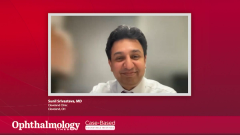
Treatment Strategies for Chronic Postoperative Uveitis
Sunil Srivastava, MD, details his approach to treating chronic non-infectious uveitis and macular edema, highlighting when to transition away from topical therapies.
This is a video synopsis of a discussion involving Sunil Srivastava, MD, a uveitis and retina specialist at the Cleveland Clinic. He delved into the management of postoperative macular edema and treatment strategies, addressing challenges often presented by patients referred by cataract or anterior segment surgeons.
The importance of a comprehensive clinical exam was emphasized, with attention to potential complications from the preceding surgery, such as lens dislocation or signs of UGH (Uveitis-Glaucoma-Hyphema) syndrome. Imaging, including OCT (Optical Coherence Tomography) and fluorescein angiogram, was discussed, particularly in cases where distinguishing between diabetic retinopathy and macular edema was challenging.
Consensus among the specialists leaned towards starting with topical therapy, with a preference for difluprednate. The discussion touched on the use of non-steroidal medications and the decision-making process when topical treatments prove insufficient or intolerable for the patient.
The panel explored the definition of chronic macular edema, with considerations such as persistent edema despite treatment, intolerance to drops, or concerns about adherence. The timeframe for defining chronicity varied among practitioners, with some considering it after multiple injections or around the six-month mark. The next line of treatment often involved intravitreal dexamethasone implants, and in cases of chronicity, some practitioners considered intravitreal fluocinolone acetonide implants for sustained control.
The importance of monitoring intraocular pressure in patients undergoing steroid treatment was underscored, emphasizing the need for vigilant assessment to prevent complications. The discussion provided valuable insights and practical pearls for managing postoperative macular edema, acknowledging the diversity in practice patterns among specialists.
Video synopsis is AI-generated and reviewed by Ophthalmology Times® editorial staff.
Newsletter
Don’t miss out—get Ophthalmology Times updates on the latest clinical advancements and expert interviews, straight to your inbox.






